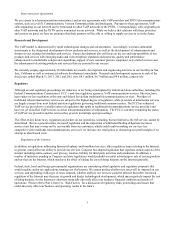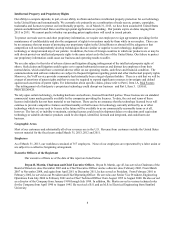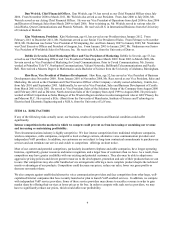8x8 2013 Annual Report Download - page 19
Download and view the complete annual report
Please find page 19 of the 2013 8x8 annual report below. You can navigate through the pages in the report by either clicking on the pages listed below, or by using the keyword search tool below to find specific information within the annual report.17
The dilution to our existing stockholders from the issuance of additional shares of common stock or reduction of
earnings per outstanding share in connection with an acquisition that fails to increase the value of our company.
As a result of these potential problems and risks, businesses that we may acquire or invest in may not produce the revenue,
earnings, or business synergies that we anticipated. In addition, there can be no assurance that any potential transaction will be
successfully identified and completed or that, if completed, the acquired business or investment will generate sufficient revenue
to offset the associated costs or other potential harmful effects on our business.
Increased taxes on our service will increase our customers' cost of using our service and/or reduce our profit margins
(to the extent the costs are not passed through to our customers) and we may be subject to liabilities for past sales and
additional taxes, surcharges and fees.
Until 2007, we did not collect or remit state or municipal taxes, such as sales, excise, and ad valorem taxes, fees or surcharges
on the charges to our customers for our services, except that we have historically complied with the collection of California
sales tax and financial contributions to the 9-1-1 system and the federal Universal Service Fund. We have received inquiries or
demands from a number of state and municipal taxing agencies seeking payment of taxes, fees or surcharges that are applied to
or collected from customers of providers of traditional public switched telephone network services. Although we have
consistently maintained that these taxes, fees or surcharges do not apply to our service for a variety of reasons depending on the
statute or rule that establishes such obligations, a number of states have changed their statutes as part of streamlined sales tax
initiatives and we are now collecting and remitting sales taxes in those states. The collection of these taxes, fees or surcharges
will have the effect of decreasing any price advantage we may have over other providers who have historically paid these taxes
and fees. Our compliance with these tax initiatives will also make us less competitive with those competitors who choose not to
comply with these tax initiatives. Currently, three jurisdictions are conducting sales tax audits of our records. As of March 31,
2013, there has been no change in the status of the assessment. We collect and have accrued for taxes that we believe are
required to be remitted. While historically, the amounts that have been remitted have been within established accruals if our
ultimate liability exceeds the accrued amount, it could result in significant charges to our earnings.
Our emergency and E-911 calling services are different from those offered by traditional wireline telephone companies
and may expose us to significant liability. There may be risks associated with limitations associated with E-911
emergency dialing with the 8x8 service.
Both our emergency calling service and our E-911 calling service are different, in significant respects, from the emergency
calling services offered by traditional wireline telephone companies. In each case, the differences may cause significant delays,
or even failures, in callers' receipt of the emergency assistance they need.
We are offering E-911 service that is similar to the emergency calling services provided to customers of traditional wireline
telephone companies in the same area. For those customers located in an E-911 area, emergency calls are routed directly to an
emergency services dispatcher at the PSAP in the area of the customer's registered location. The dispatcher will have automatic
access to the customer's telephone number and registered location information. If a customer moves their 8x8 service to a new
location, the customer's registered location information must be updated and verified by the customer. Until that takes place,
the customer will have to verbally advise the emergency dispatcher of his or her actual location at the time of an emergency 9-
1-1 call. This can lead to delays in the delivery of emergency services.
The emergency calls of customers located in areas where we are currently unable to provide E-911 service as described above
are supported by a national call center that is run by a third party provider and operates 24 hours per day, seven days per week.
These operators still receive the customer's registered service location and phone number automatically, and coordinate
connecting the caller to the appropriate PSAP or emergency services provider and providing the customer's registered service
location and phone number to those local authorities, which can also delay the delivery of emergency services. In the event that
a customer experiences a broadband or power outage, or if a network failure were to occur, the customer will not be able to
reach an emergency services provider using our services.
The FCC may determine that our nomadic emergency calling solution does not satisfy the requirements of its VoIP E-911
order because, in some instances, our nomadic emergency calling solution requires that we route an emergency call to a
national emergency call center instead of connecting our customers directly to a local PSAP through a dedicated connection
and through the appropriate selective router. The FCC may issue further guidance on compliance requirements in the future
that might require us to disconnect those customers not receiving access to emergency services in a manner consistent with the
VoIP E-911 order. The effect of such disconnections, monetary penalties, cease and desist orders or other enforcement actions
























